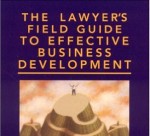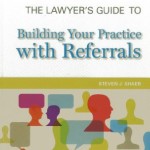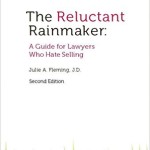The San Francisco Law Library maintains a comprehensive Law Practice Management Collection, with publications that detail all aspects of opening a practice—hanging your shingle, billing, finances, risk management, technology, and more. This post introduces the Law Library’s LPM resources that help lawyers market their practice and attract clients. Stay tuned for future installments that highlight the Law Library’s materials on additional LPM topics.
The Consumer Law Revolution: The Lawyer’s Guide to the Online Legal Marketplace, by Stephanie L. Kimbro. American Bar Association, Law Practice Management Section, 2013.
 Legal technology startups are capturing the innumerable consumers who go online in search of legal assistance, and there is plenty of opportunity for lawyers to collaborate with these networks and generate business for themselves. This practical manual will teach you how to develop an online presence, navigate the online legal marketplace and its ethical implications, and position yourself for the future as the nature of how clients connect to lawyers changes.
Legal technology startups are capturing the innumerable consumers who go online in search of legal assistance, and there is plenty of opportunity for lawyers to collaborate with these networks and generate business for themselves. This practical manual will teach you how to develop an online presence, navigate the online legal marketplace and its ethical implications, and position yourself for the future as the nature of how clients connect to lawyers changes.
How to Capture and Keep Clients: Marketing Strategies for Lawyers, edited by Jennifer J. Rose. American Bar Association, Solo, Small Firm and General Practice Division, 2015.
 More than 20 lawyers share the marketing tips that led to their success in concise chapters that focus on a different aspect of legal marketing. Topics include how to overcome the challenge of asking for business, how to identify and sell to your ideal clients, how to market yourself to other lawyers as a contract attorney, how to use your bills as a business development tool, how to make rainmaking part of your daily routine, and how to avoid common ethical mistakes in marketing.
More than 20 lawyers share the marketing tips that led to their success in concise chapters that focus on a different aspect of legal marketing. Topics include how to overcome the challenge of asking for business, how to identify and sell to your ideal clients, how to market yourself to other lawyers as a contract attorney, how to use your bills as a business development tool, how to make rainmaking part of your daily routine, and how to avoid common ethical mistakes in marketing.
The Lawyer’s Field Guide to Effective Business Development, by William J. Flannery. American Bar Association, Law Practice Division, 2nd ed., 2014.
 This book stands out for its emphasis on developing the face-to-face skills that lawyers need to build enduring client relationships. After all, these relationships are not only what makes a law firm thrive economically, but they also generate other business and lead to greater personal satisfaction. Plus, in the aftermath of the Great Recession, a successful practice requires anticipating clients’ business needs and devising a legal solution—in effect, “solving problems the client didn’t clearly see.” The five-step approach to business development set out in this book will show you how to focus on clients’ needs with measurable results to make sure there is a profitable return on investment for your firm.
This book stands out for its emphasis on developing the face-to-face skills that lawyers need to build enduring client relationships. After all, these relationships are not only what makes a law firm thrive economically, but they also generate other business and lead to greater personal satisfaction. Plus, in the aftermath of the Great Recession, a successful practice requires anticipating clients’ business needs and devising a legal solution—in effect, “solving problems the client didn’t clearly see.” The five-step approach to business development set out in this book will show you how to focus on clients’ needs with measurable results to make sure there is a profitable return on investment for your firm.
The Lawyer’s Guide to Building Your Practice with Referrals, by Steven J. Shaer. American Bar Association, Law Practice Management Section, 2012.
 This is a book “for the rest of us”—those without a natural gift as a rainmaker. With the understanding that “people buy legal services from people,” rather than from law firms, it delves into business development theory, technique, and practice with the goal of using personal interactions to grow your practice. Referrals significantly shorten the business development process, so read this book to learn how to evaluate the referral potential of an acquaintance, build strong relationships, and gain skills to get the most out of networking events.
This is a book “for the rest of us”—those without a natural gift as a rainmaker. With the understanding that “people buy legal services from people,” rather than from law firms, it delves into business development theory, technique, and practice with the goal of using personal interactions to grow your practice. Referrals significantly shorten the business development process, so read this book to learn how to evaluate the referral potential of an acquaintance, build strong relationships, and gain skills to get the most out of networking events.
The Lawyers Ultimate Guide to Online Leads: Getting More Clients from the Web into Your Law Practice, Step-by-Step, by Ken Matejka. Cartwright Publishing, 2nd ed., 2016.
 Now that the era of Yellow Page advertising is long gone, lawyers need to know not only how to market with a website and social media, but also how to convert online interest into paying clients. To be an effective lead generator, your online presence must attract a high number of visitors, and then encourage those visitors to contact your firm. Author Ken Matejka is a renowned expert in online marketing for lawyers and the former Operations Manager of BASF’s Lawyer Referral and Information Service. His comprehensive marketing plan teaches how to maximize the potential of the internet, and of course, how to close the deal and sign the client. This updated 2016 edition covers recent changes to the realm of online legal marketing, such as Google’s “Call-only” ads, how not having a mobile-friendly website will affect search rankings, and more.
Now that the era of Yellow Page advertising is long gone, lawyers need to know not only how to market with a website and social media, but also how to convert online interest into paying clients. To be an effective lead generator, your online presence must attract a high number of visitors, and then encourage those visitors to contact your firm. Author Ken Matejka is a renowned expert in online marketing for lawyers and the former Operations Manager of BASF’s Lawyer Referral and Information Service. His comprehensive marketing plan teaches how to maximize the potential of the internet, and of course, how to close the deal and sign the client. This updated 2016 edition covers recent changes to the realm of online legal marketing, such as Google’s “Call-only” ads, how not having a mobile-friendly website will affect search rankings, and more.
Personal Branding in One Hour for Lawyers, by Katy Goshtasbi. American Bar Association, Section of Law Practice Management, 2013.
 While this is not a book on marketing per se, personal branding is intertwined with marketing. In order to differentiate yourself from other lawyers, you must establish a clear, consistent message of who you are, regardless of whether you work for a large firm or as a solo practitioner. This is the first book to focus on personal branding exclusively for lawyers, and it reveals how to identify the unique selling proposition that distinguishes you as a lawyer, how to apply that message to visual branding, and how to communicate it via marketing materials and networking events.
While this is not a book on marketing per se, personal branding is intertwined with marketing. In order to differentiate yourself from other lawyers, you must establish a clear, consistent message of who you are, regardless of whether you work for a large firm or as a solo practitioner. This is the first book to focus on personal branding exclusively for lawyers, and it reveals how to identify the unique selling proposition that distinguishes you as a lawyer, how to apply that message to visual branding, and how to communicate it via marketing materials and networking events.
The Reluctant Rainmaker: A Guide for Lawyers Who Hate Selling, by Julie A. Fleming, J.D. Crow Creek Press, 2nd ed., 2014.
 “What do you call a solo who cannot make rain?” asks author Julie A. Fleming. The answer is not pretty: “Broke. A job seeker. And possibly unemployable.” Most lawyers do not have a knack for generating business, and some genuinely loathe it. But business development is essential to a successful solo practice—being a good lawyer is simply insufficient in today’s competitive legal market. Rainmaking is a learnable skill, and this book helps you identify your strengths and create a business development plan to match.
“What do you call a solo who cannot make rain?” asks author Julie A. Fleming. The answer is not pretty: “Broke. A job seeker. And possibly unemployable.” Most lawyers do not have a knack for generating business, and some genuinely loathe it. But business development is essential to a successful solo practice—being a good lawyer is simply insufficient in today’s competitive legal market. Rainmaking is a learnable skill, and this book helps you identify your strengths and create a business development plan to match.
Renegade Lawyer Marketing: How Today’s Solo and Small Firm Lawyers Survive and Thrive in a World of Marketing Vultures, 800 Pound Gorillas, and LegalZoom, by Benjamin W. Glass, III. Word Association Publishers, 2015.
 Author Ben Glass is an expert legal marketer and owner of Great Legal Marketing. He posits that successful legal marketing begins with dropping your sense of entitlement, understanding your “why,” and believing that you craft your own existence—“blind luck is not a good business plan,” in Mr. Glass’ words. Learn how to create a marketing message that differentiates you from the competition, market to your ideal clients, convert leads, and much more.
Author Ben Glass is an expert legal marketer and owner of Great Legal Marketing. He posits that successful legal marketing begins with dropping your sense of entitlement, understanding your “why,” and believing that you craft your own existence—“blind luck is not a good business plan,” in Mr. Glass’ words. Learn how to create a marketing message that differentiates you from the competition, market to your ideal clients, convert leads, and much more.
Smart Marketing for the Small Firm Lawyer, by Kenneth Vercammen. American Bar Association, General Practice, Solo & Small Firm Division, 2014.
 This quick read gives an overview of every marketing activity that lawyers should employ, including how to set up best practices within your firm. The takeaway from this book is that marketing must be a constant, daily routine, and the author shares his boundless enthusiasm along with creative ideas to connect with members of your local community. It also contains examples of the author’s advertising materials, letters, and the like.
This quick read gives an overview of every marketing activity that lawyers should employ, including how to set up best practices within your firm. The takeaway from this book is that marketing must be a constant, daily routine, and the author shares his boundless enthusiasm along with creative ideas to connect with members of your local community. It also contains examples of the author’s advertising materials, letters, and the like.
About the author:
Andrea Woods is a Reference Librarian at the San Francisco Law Library.


